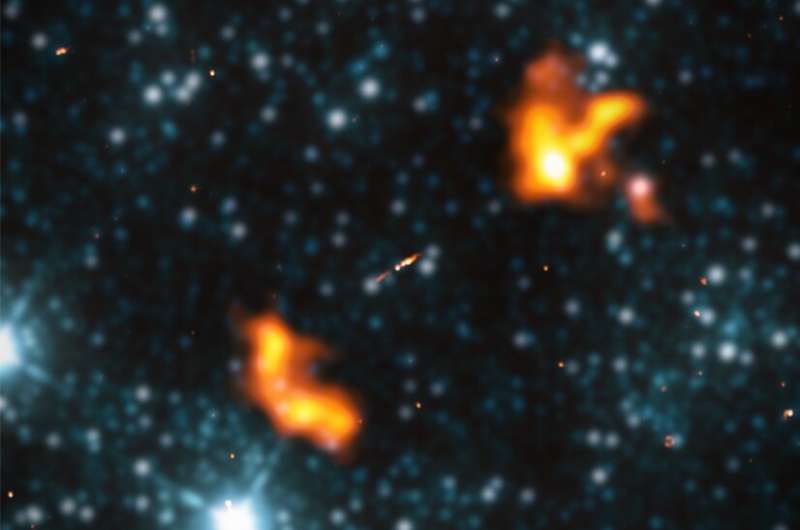February 21, 2022 report
New giant radio galaxy detected

European astronomers report the detection of a new giant radio galaxy (GRG) as part of the LOFAR Two-meter Sky Survey (LoTSS). The newly found object, named Alcyoneus, turns out to be the largest GRG known to date. The finding is detailed in a paper published February 11 on the arXiv pre-print repository.
GRG are radio galaxies with an overall projected linear length exceeding at least 2.3 million light years. They are rare objects grown in low-density environments. In general, GRGs are important for astronomers to study the formation and the evolution of radio sources.
So far, about a thousand GRGs have been detected, out of which only ten exceed 10 million light years in size. The largest one is J1420-0545—with a projected proper length of approximately 16 million light years. Therefore, GRGs and also the rest of the megaparsec-scale radio galaxies are assumed to be the largest single-galaxy–induced phenomena in the universe.
Now, a team of astronomers led by Martijn S.S.L. Oei of Leiden University in the Netherlands, have found a new giant radio galaxy that appears to be the largest one of the other known GRGs. The finding was made by analyzing the second data release (DR2) from LoTSS.
"We reprocess the LoTSS DR2, the latest version of the LOFAR's Northern Sky survey at 144 MHz, by subtracting angularly compact sources and imaging at 60'' and 90'' resolution. The resulting images allow us to explore a new sensitivity regime for radio galaxy lobes, and thus represent promising data to search for unknown GRGs of large angular length," the researchers wrote in the paper.
The astronomers identified a three-component radio structure that turned out to be a giant radio galaxy with a central (jet-like) component and two outer (lobe-like) components. They dubbed this GRG Alcyoneus and found that it has a projected proper length of about 16.26 million light years, while its true proper length was estimated to be 16.43 million light years. This makes it the largest known structure made by a single galaxy.
According to the research, Alcyoneus has a total luminosity density at 144 MHz of some 80 YW/Hz—therefore typical for giant radio galaxies. It was found that the host of this GRG is the elliptical galaxy J081421.68+522410.0 with a stellar mass of approximately 240 billion solar masses and a supermassive black hole (SMBH) mass of about 400 million solar masses.
The authors of the paper noted that Alcyoneus' host has a fairly low stellar mass and SMBH mass when compared with other GRG hosts. This, according to them, suggests that—within the GRG population—no strong positive correlation between radio galaxy length and (instantaneous) low-frequency radio power, stellar mass or SMBH mass can exist.
"Thus, very massive galaxies or central black holes are not necessary to grow large giants, and, if the observed state is representative of the source over its lifetime, neither is high radio power," the researchers concluded.
More information: Martijn S.S.L. Oei et al, The discovery of a radio galaxy of at least 5 Mpc. arXiv:2202.05427v1 [astro-ph.GA], arxiv.org/abs/2202.05427
© 2022 Science X Network





















